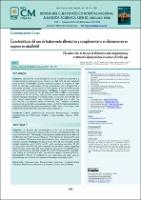| dc.contributor.author | Díaz Vélez, Cristian | |
| dc.contributor.author | Vargas Tineo, Otto W. | |
| dc.contributor.author | Segura Muñoz, Dina M. | |
| dc.contributor.author | Calderón Rodríguez, Karla V. | |
| dc.contributor.author | Apolaya Segura, Moisés | |
| dc.contributor.author | Carhuapoma Yance, Mario | |
| dc.date.accessioned | 2023-05-17T21:58:32Z | |
| dc.date.available | 2023-05-17T21:58:32Z | |
| dc.date.issued | 2021-12-31 | |
| dc.identifier.citation | Revista del Cuerpo Médico Hospital Nacional Almanzor Aguinaga Asenjo. 2021:14(4). | es_PE |
| dc.identifier.issn | 2227-4731 | |
| dc.identifier.uri | https://hdl.handle.net/20.500.12959/3686 | |
| dc.description.abstract | Objetivo: Describir las características del uso de tratamiento alternativo y
complementario en dismenorrea en mujeres en edad fértil de una ciudad del
norte de Perú. El estudio: Estudio trasversal analítico en mujeres en edad
fértil en Mórrope, Lambayeque. Previa capacitación sobre dismenorrea y
principales variables. Se entrevistó a 336 mujeres en sus domicilios previa
aceptación de consentimiento informado. Hallazgos: Predominó en población
estudiada el grupo etario de 15 a 35 años con 83,92% (n=282), con educación
secundaria el 57,14% (n=192), más del 90% tenían estrato socioeconómico
inferior/marginal. Referente a la dismenorrea, se encontró más del 30% con
dolor severo/insoportable, cuyo tratamiento principal fue la MAC con
82,1%(n=220). Las plantas fueron la principal MAC, hallando solamente
asociación de uso de MAC con la variable religión (p=0,023). Conclusiones: Las
mujeres en edad fértil emplean notoriamente la MAC, como la fitoterapia, como
tratamiento de dismenorrea a pesar de no encuentran alivio. | es_PE |
| dc.description.abstract | Objetive: To describe the characteristics of the use of alternative and
complementary treatment in dysmenorrhea in women of childbearing age in a
city in northern Peru. The study: Cross-sectional analytical study in women of
childbearing age in Mórrope, Lambayeque. Prior training on dysmenorrhea and
main variables. 336 women were interviewed in their homes after accepting
informed consent. Findings: The age group of 15 to 35 years prevailed in the
studied population with 83.92% (n=282), with secondary education 57.14%
(n=192), more than 90% had lower/marginal socioeconomic status. Regarding
dysmenorrhea, more than 30% were found to have severe/unbearable pain,
whose main treatment was MAC with 82.1% (n=220). Plants were the main MAC,
only finding an association of MAC use with the religion variable (p=0.023).
Conclusions: Women of childbearing age notoriously use CAM, such as
phytotherapy, as a treatment for dysmenorrhea despite not finding relief | es_PE |
| dc.format | application/pdf | es_PE |
| dc.language.iso | spa | es_PE |
| dc.publisher | Seguro Social de Salud (EsSalud) | es_PE |
| dc.relation.uri | http://cmhnaaa.org.pe/ojs/index.php/rcmhnaaa/article/view/1459 | es_PE |
| dc.rights | info:eu-repo/semantics/openAccess | es_PE |
| dc.rights.uri | https://creativecommons.org/licenses/by-nc-sa/4.0/ | es_PE |
| dc.subject | Dismenorrea | es_PE |
| dc.subject | Síndrome premenstrual | es_PE |
| dc.subject | Terapias complementarias | es_PE |
| dc.subject | Fitoterapia | es_PE |
| dc.subject | Religión o espiritualidad | es_PE |
| dc.subject | Dysmenorrhea | es_PE |
| dc.subject | Premenstrual syndrome | es_PE |
| dc.subject | Complementary therapies | es_PE |
| dc.subject | Phytotherapy | es_PE |
| dc.subject | Religion or spirituality | es_PE |
| dc.title | Características del uso de tratamiento alternativo y complementario en dismenorrea en mujeres en edad fértil | es_PE |
| dc.title.alternative | Characteristics of the use of alternative and complementary treatment in dysmenorrhea in women of fertile age | es_PE |
| dc.type | info:eu-repo/semantics/article | es_PE |
| dc.subject.ocde | https://purl.org/pe-repo/ocde/ford#3.02.02 | es_PE |
| dc.identifier.doi | https://doi.org/10.35434/rcmhnaaa.2021.144.1459 | |






